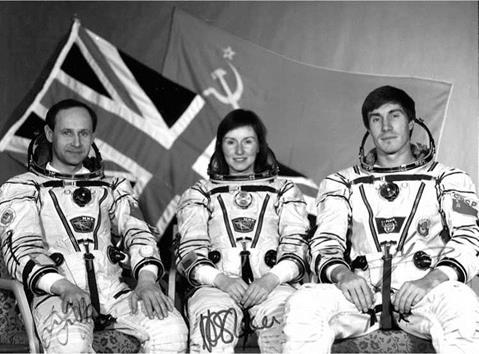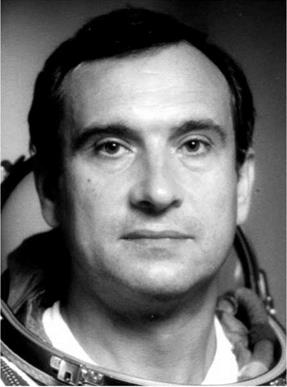MORE ADDITIONS TO MIR
The delivery of Kvant allowed some cargo to be brought to Mir as well; one of the items stuffed inside the new laboratory was a new set of solar arrays that the crew would locate on the base block of Mir. It arrived in two sections, so the crew would need to venture outside twice to finish the work. During the previous Extravehicular Activity (EVA), physicians on the ground had noticed irregularities in Faveikin’s heart rhythm which caused them some concern; however, after further studies it was decided to allow him to carry out installation assembly. The two spacewalks were carried out without incident, and the installation added about 2.5 kW of power to the station’s total supply. Unfortunately, the spacewalks allowed the doctors on the ground to further study Faveikin’s heart, and they came to the conclusion that they could not tell enough from the remote telemetry to perform a proper diagnosis. Poor Faveikin was told to try and relax, and a plan was put in place to get him home as soon as possible. The next crew would arrive in July, and would consist of Aleksandr Viktorenko, Aleksandr Aleksandrov, and a Syrian visitor, Mohammed Faris. In order to relieve Faveikin, Alexandrov would replace him on the permanent crew and Faveikin would return to Earth on board Soyuz-TM 2 with Viktorenko and Faris in July 1987.
Romanenko had now been in space for the best part of a year, and the end of his flight was approaching. He had hoped to increase the endurance record to a full year, but his increasing testiness with the ground and his crewmates convinced Soviet officials to bring him home short of his goal. He returned to Earth on board Soyuz-TM 3 with Aleksandr Aleksandrov and Anatoli Fevchenko who had been launched on a taxi mission toward the end of December. Fevchenko was another member of the Buran test pilot group and he, like Igor Volk, was flying to check the landing ability of a cosmonaut after exposure to weightlessness. Immediately after landing he was flown by helicopter to a Tu-154 civil airliner which he used to simulate Buran landings. The Buran program was in crisis, however, and faced cancelation at any moment. Despite this fact, Buran made its first flight, unmanned, in November 1988, completing one orbit before returning to the launch site under remote control, accompanied by a MiG-25 chase plane flown by Igor Volk. This flight was a significant achievement (the U. S. shuttle could not be flown unmanned, as it at least required a crew member to lower the landing gear) but it had come too late to save the program. The planned flight to Mir, which was scheduled for December 1994, was canceled, and the program itself was concluded in June 1993 by Boris Yeltsin.
It would fall to the very next crew to break the one year in space barrier. Vladimir Titov, finally breaking his jinx, and Musa Manarov, a rookie cosmonaut, were to fly to Mir on board Soyuz-TM 4 with Levchenko, and return to Earth 365 days later on Soyuz-TM 6. At the end of their marathon flight, Dr. Valeri Polyakov would begin the first of his record-breaking flights. The timing of his flight was important; he wanted the chance to observe Titov and Manarov whilst they were still in space to see for himself the medical effects of such a long flight, before he began one of his own. His mission continued well, and when Titov and Manarov returned to Earth he was joined by Aleksandr Volkov and Sergei Krikalev who, it was planned, he would finish the long-duration mission with. However, on the ground things were not proceeding so well. Volkov and Krikalev had been trained to receive the next new modules to expand the Mir complex, but the construction of those modules had slowed to a crawl; there simply was not the money to complete them, let alone launch them. Finally it was decided to bring the crew home and mothball the station for the next five months. Polyakov was devastated, despite having spent 240 days in orbit, and upon his landing immediately began canvassing for another, longer mission.
Aleksandr Viktorenko and Aleksandr Serebrov were the next occupants of Mir; they launched on board Soyuz TM-8 on 5 September 1989, and entered the station a few days later. The second Mir expansion module was now ready after the delays, and on 26 November it was launched to dock at Mir’s front port. The flight to Mir was not entirely smooth; one solar array initially failed to deploy, but was shaken loose by putting the module into a slow roll. Even when it arrived at the station, its Kurs automatic docking system aborted the first docking attempt; however a second docking four days later was successful. Kvant 2, as it was known, then swung itself to an upper docking port by using its Ljappa “swing arm’’ to rotate itself 90 degrees before reattaching itself to Mir. When the cosmonauts entered the new module they found three new compartments. The nearest compartment gave the cosmonauts some new home comforts, a shower, and a second toilet. The middle area contained room for scientific experiments, but could also be used as a back-up airlock. The compartment at the end of the module was intended to be Mir’s main airlock; it had enough room to store extra spacesuits, and a wide outward opening. One of the reasons for the wider hatch was also contained in the area, the Soviet version of a manned maneuvr – ing unit, called Icarus. The first test of the Icarus unit, which was intended to be used later with the Buran space shuttle, would be slightly different from the one undertaken by NASA’s Bruce McCandless and Bob Stewart on the shuttle mission
STS-41B five years earlier. Serebrov and Viktorenko remained tethered to the station throughout their test, and whilst McCandless and Stewart had been able to fly free of the shuttle up to distances of 320 ft, the cosmonauts never reached more than 150 ft. The reason for this, of course, was the fact that if the unit had failed, the shuttle would have been able to go and collect McCandless or Stewart; Mir could not really go anywhere to retrieve anyone. This would prove to be the first and last use of the Icarus system, it was thought to be too complicated and risky to use, and eventually was left outside the station to free up space in the airlock.
 |
The next new Mir module, Kristall, arrived at the station in June of 1990. Once again the first docking was aborted by the automatic system, and again the second attempt was successful. In the same manner as Kvant 2 before it, Kristall’s own small robot arm moved the module to its dedicated docking port on the node, directly opposite Kvant 2, giving the station a “T” shape. Kristall’s interior was very different from Kvant 2; it was mostly fitted out with furnaces to allow metallurgy and crystal – growth experiments. At the far end of the module was a docking unit to allow the Soviet shuttle Buran to dock; this would never be used by Buran, but it would be used once by a suitably fitted out Soyuz, and then much later and ironically, by the U. S. space shuttle. Although both of the new modules added significant internal volume to
|
Soyuz-TM 12 crew, with British astronaut Helen Sharman |
the station, it was still a great deal less than Skylab had provided its crews, and the total weight of the complex was about 12 tons less than Skylab too.
Mir now settled into a period of long-duration missions intermingled with visits by international cosmonauts. Visitors from Japan, Great Britain, Austria, France, and the newly reunified Germany took place over the next four years.
The most significant long-duration missions were undertaken by Sergei Krikalev who spent 311 days in 1991/2 in addition to the 151 days that he had accumulated in 1988/9. Whilst he was there, the world below him changed. He was launched as a Soviet citizen, but the revolution that caused the Soviet Union to collapse also returned him to Earth as a Russian citizen. He was dubbed “The Last Soviet Citizen” by the press. He would go on to fly two more mission to the ISS, to bring his total time spent in space to 803 days; over 50 more than the previous record holder. At the time of writing Krikalev is due to return to the ISS as commander of Expedition 19 in March 2009.
However, the man to have spent the most time in orbit in a single mission is Dr. Valeri Polyakov. In January 1994 he returned to the station with Viktor Afanasyev and Yury Usachev on Soyuz-TM 18. Polyakov had managed to sell the idea of an ultra-long-duration flight to the space program officials on the basis that it would attract new international interest in joint missions, interest that would
|
Dr. Valeri Polyakov |
bring much needed currency to the now Russian space program. On his arrival, he was welcomed by Aleksandr Serebrov and Vasily Tsibliyev, who were due to return to Earth a few days later. Tsibliyev was on his first space flight, and Serebrov his last after four missions. When they undocked from the station, Tsibliyev flew a fly-by to take photographs of Mir. Unfortunately, the Soyuz gave the Kristall module a glancing blow. Worse collisions were to come in later years for both Tsibliyev and Mir, but for now no damage was done, and the spacecraft returned to Earth without further incident. Polyakov could be forgiven for thinking that his much-wished-for mission might be over before it hardly began, but no damage had been done to the station either, and the mission proceeded. His stay, beyond being almost indescribably long, was also uneventful, and on 22 March 1995 he climbed into Soyuz-TM 20 along with Aleksandr Viktorenko and Yelena Kondakova to return home. He had spent almost 438 days in orbit, and when his capsule landed in Kazakhstan he walked from it to a nearby chair, a tremendous achievement. He also stole a cigarette from a friend nearby, but could hardly be blamed for that. He sipped a small brandy and inwardly celebrated his mission. His record still stands today, and it is unlikely to be broken until man ventures to Mars.
Altogether, 28 “main expeditions” worked aboard Mir, and they were visited by many short-term crews. A total of 104 men and women visited Mir, including 42 Soviet or Russian citizens. The remainder comprised 44 from America, 5 from France, 3 from the European Space Agency, 2 from Germany, and one each from Syria, Bulgaria, Afghanistan, Japan, the United Kingdom, Austria, Slovakia, and Canada.
On 23 March 2001, Mir was de-orbited over the Pacific Ocean, with any hardware that survived the entry process falling harmlessly into the sea. It was truly the end of a remarkable era; for 15 years Mir had orbited the Earth, and whilst in its final years it may not have been pretty, it was the greatest single achievement yet in the history of manned spaceflight.












